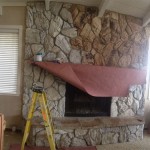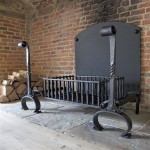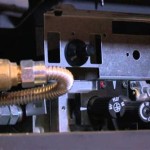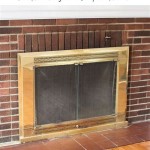Indoor Wood Burning Fireplace Kits: An Exploration of Options and Considerations
Indoor wood-burning fireplace kits offer a practical and aesthetically pleasing solution for adding the warmth and ambiance of a traditional fireplace to a home. These kits provide a pre-engineered, often modular, approach to fireplace construction, simplifying the installation process compared to building a fireplace from scratch. This article explores the various types of indoor wood-burning fireplace kits, discusses essential factors to consider before purchasing, and offers insights into installation and safety practices.
The appeal of a wood-burning fireplace stems from its ability to generate radiant heat, create a focal point in a room, and contribute to a cozy and inviting atmosphere. While traditional masonry fireplaces possess undeniable charm, they can be expensive and time-consuming to construct. Indoor wood-burning fireplace kits provide a viable alternative, offering a more streamlined approach to achieving similar results. These kits typically include the firebox, chimney components, and sometimes decorative elements, all designed to work together seamlessly.
Understanding Different Types of Indoor Wood-Burning Fireplace Kits
The market offers a range of indoor wood-burning fireplace kits, each catering to specific needs and preferences. Understanding the variations is crucial for selecting the right kit for a particular application. These kits can be broadly categorized by their installation type and the materials used in their construction.
Zero-Clearance Fireplace Kits: These are among the most popular types of indoor wood-burning fireplace kits. Zero-clearance fireplaces are designed to be installed directly against combustible materials like wood framing. This feature significantly simplifies installation and allows for greater flexibility in placement within a room. The firebox is typically encased in an insulated shell that prevents heat transfer to surrounding structures, ensuring safety and compliance with building codes. Zero-clearance kits are often chosen for new construction or when retrofitting an existing space with a fireplace.
Insert Kits: Fireplace insert kits are designed to be installed within an existing masonry fireplace. Instead of building a new fireplace from scratch, an insert offers a way to improve the efficiency and safety of an existing, potentially inefficient, fireplace. These inserts are essentially enclosed fireboxes that are slid into the existing fireplace opening and connected to the chimney. Inserts typically feature a glass door to control airflow and prevent smoke from entering the room. They are available in various sizes and styles to fit different fireplace openings and can significantly improve the heating performance of an older fireplace.
Corner Fireplace Kits: Corner fireplace kits are specifically designed to fit into the corner of a room. This configuration can be advantageous in spaces where wall space is limited. Corner fireplaces often feature a unique design that maximizes the viewing angle of the fire. They are available in both zero-clearance and insert versions, offering flexibility in terms of installation options.
Material Variations: Fireplace kits also vary in terms of the materials used in their construction. The firebox is typically made of heavy-duty steel or cast iron, designed to withstand high temperatures. The exterior of the fireplace can be finished with a variety of materials, including brick, stone, tile, or metal. The choice of materials will influence the overall aesthetic of the fireplace and its compatibility with the existing décor of the room.
Key Factors to Consider Before Purchasing a Wood-Burning Fireplace Kit
Selecting the appropriate indoor wood-burning fireplace kit requires careful consideration of several factors. These include the size and layout of the room, the desired heating capacity, local building codes, and budget constraints. A thorough assessment of these factors will help ensure that the chosen kit meets the homeowner's needs and complies with all applicable regulations.
Room Size and Heating Capacity: The size of the room in which the fireplace will be installed is a critical consideration. A fireplace that is too large for the space can overheat the room, while one that is too small may not provide sufficient heat. Fireplace manufacturers typically specify the heating capacity of their products in terms of British Thermal Units (BTUs) or square footage. It is important to select a fireplace with a heating capacity that is appropriate for the size of the room.
Building Codes and Regulations: All wood-burning fireplaces must comply with local building codes and regulations. These codes typically address issues such as clearance to combustible materials, chimney height, and fire safety requirements. It is essential to consult with local building officials or a qualified contractor to ensure that the chosen fireplace kit meets all applicable requirements. Failure to comply with building codes can result in fines, delays in installation, or even the rejection of the project.
Installation Requirements: The installation of a wood-burning fireplace kit can be a complex process that requires specialized knowledge and skills. While some homeowners may choose to install the kit themselves, it is generally recommended to hire a qualified contractor. A professional installer will have the experience and expertise to ensure that the fireplace is installed safely and correctly. Furthermore, a professional installation can often be required to maintain the manufacturer's warranty.
Chimney Requirements: The chimney is a crucial component of any wood-burning fireplace system. It is responsible for venting smoke and combustion gases safely outside the building. The chimney must be of the correct size and height to ensure proper draft and prevent backdrafting. Fireplace kits often include chimney components, but it is important to verify that these components are compatible with the fireplace and meet local building codes. In some cases, it may be necessary to purchase additional chimney components or modify an existing chimney.
Aesthetic Considerations: The aesthetic appeal of the fireplace is another important factor to consider. The fireplace should complement the overall style of the room and enhance its visual appeal. Fireplace kits are available in a wide range of styles, from traditional to contemporary. Homeowners can choose from a variety of materials and finishes to create a fireplace that reflects their personal tastes.
Budget: The cost of an indoor wood-burning fireplace kit can vary significantly depending on the type of kit, the materials used, and the installation requirements. It is important to establish a budget before beginning the shopping process. The budget should include the cost of the fireplace kit itself, as well as the cost of installation, chimney components, and any necessary building permits.
Installation and Safety Practices for Wood-Burning Fireplace Kits
Proper installation and adherence to safety practices are paramount when it comes to wood-burning fireplaces. Incorrect installation can lead to fire hazards, smoke leakage, and other problems. Regular maintenance and safe operating procedures are equally important for ensuring the long-term safety and efficiency of the fireplace.
Professional Installation: As mentioned earlier, professional installation is highly recommended for wood-burning fireplace kits. A qualified contractor will have the knowledge and experience to install the fireplace safely and correctly, ensuring that it complies with all applicable building codes. The contractor will also be able to advise on the proper operation and maintenance of the fireplace.
Chimney Inspection and Cleaning: Regular chimney inspection and cleaning are essential for preventing chimney fires. Creosote, a flammable byproduct of wood combustion, can build up inside the chimney over time. If creosote accumulates to a sufficient thickness, it can ignite and cause a chimney fire. It is recommended to have the chimney inspected and cleaned by a qualified chimney sweep at least once a year, or more frequently if the fireplace is used frequently.
Proper Wood Storage and Handling: Proper wood storage and handling are also important for safety. Wood should be stored in a dry, well-ventilated area away from the house. Never stack wood directly against the house, as this can create a fire hazard. Only dry, seasoned wood should be burned in the fireplace. Burning wet or green wood can produce excessive smoke and creosote, increasing the risk of chimney fires.
Using a Fireplace Screen: Always use a fireplace screen when burning a fire. The screen will prevent sparks and embers from escaping the fireplace and potentially starting a fire in the room. The screen should be made of sturdy metal mesh and should fit snugly against the fireplace opening.
Carbon Monoxide Detectors: Install carbon monoxide detectors in the home, particularly near sleeping areas. Carbon monoxide is a colorless, odorless gas that can be produced by incomplete combustion of wood. Carbon monoxide poisoning can be fatal. Carbon monoxide detectors will alert occupants to the presence of carbon monoxide in the air, allowing them to evacuate the building and seek medical attention.
Educating all Occupants: Ensure that all occupants of the home are aware of the safe operating procedures for the fireplace. This includes instructions on how to start and extinguish a fire, how to properly load wood, and how to clean the fireplace. A fire safety plan should be in place, and all occupants should know what to do in the event of a fire.
By carefully considering the various types of indoor wood-burning fireplace kits available, understanding the key factors to consider before purchasing, and adhering to proper installation and safety practices, homeowners can enjoy the warmth and ambiance of a wood-burning fireplace while ensuring the safety of their homes and families.

Temp Cast Indoor Masonry Fireplace And Oven Combo Patio Outdoor Furnishings

Temp Cast Indoor Masonry Fireplace And Oven Combo Patio Outdoor Furnishings

Mason Lite Indoor Outdoor Wood Burning Fireplace Kit Patio Furnishings

Masonry Fireplace Kits Prefabricated Mason Lite

Temp Cast Indoor Masonry Fireplace And Oven Combo Patio Outdoor Furnishings

Masonry Fireplace Kits Prefabricated Mason Lite

Majestic Sb60 Biltmore 36 Inch Radiant Wood Burning Fireplace

Indoor Living And Fireplace Design Ideas Outdoor Advice Greatrooms

Majestic Sb80 Biltmore 42 Inch Radiant Wood Burning Fireplace

Modern Wood Stove Guide All You Need To Know 2024 Field Mag
Related Posts








